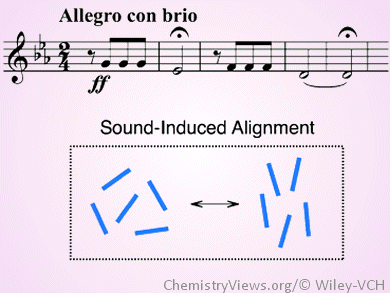Good Vibrations
Humans create and perform music for a variety of purposes, such as aesthetic pleasure, healing, religion, and ceremony. Accordingly, a scientific question arises: Can molecules or molecular assemblies interact physically with the sound vibrations of music? In the journal ChemPlusChem, Japanese researchers have now revealed their physical interaction. When classical music was playing, a designed supramolecular nanofiber in a solution dynamically aligned in harmony with the sound of music.
Sound is vibration of matter, having a frequency, in which certain physical interactions occur between the acoustically vibrating media and solute molecules or molecular assemblies. Music is an art form consisting of the sound and silence expressed through time, and characterized by rhythm, harmony, and melody. The question of whether music can cause any kind of molecular or macromolecular event is controversial, and the physical interaction between the molecules and the sound of music has never been reported.
Sound-Induced Alignment of Nanofibers
Scientists working at Kobe University and Kobe City College of Technology, Japan, have now developed a supramolecular nanofiber, composed of an anthracene derivative, which can dynamically align by sensing acoustic streaming flows generated by the sound of music. Time course linear dichroism (LD) spectroscopy could visualize spectroscopically the dynamic acoustic alignments of the nanofiber in the solution. The nanofiber aligns upon exposure to the audible sound wave, with frequencies up to 1000 Hz, with quick responses to the sound and silence, and amplitude and frequency changes of the sound wave. The sheared flows generated around glass-surface boundary layer and the crossing area of the downward and upward flows allow shear-induced alignments of the nanofiber.
Music is composed of the multi complex sounds and silence, which characteristically change in the course of its playtime. The team, led by A. Tsuda, uses “Symphony No. 5 in C minor, First movement: Allegro con brio” written by Beethoven, and “Symphony No. 40 in G minor, K. 550, First movement”, written by Mozart in the experiments. When the classical music was playing, the sample solution gave the characteristic LD profile of the music, where the nanofiber dynamically aligned in harmony with the sound of music.
- Acoustic Alignment of a Supramolecular Nanofiber in Harmony with the Sound of Music,
Ryosuke Miura, Yasunari Ando, Yasuhisa Hotta, Yoshiki Nagatani, Akihiko Tsuda,
ChemPlusChem 2014.
DOI: 10.1002/cplu.201300400



